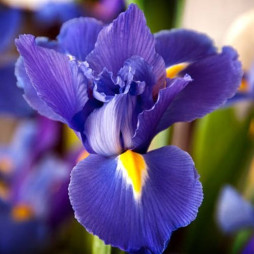Irises
Description
Named after the Greek goddess of the rainbow, irises bring color to the garden in spring and summer. With many different types and colors available, ranging from white to almost black but most common in shades of lavender, purple, white and yellow, there is an iris for nearly every garden. The most common is the bearded variety, named so because of the prominent beard of white in the center of the petal. Iris blossoms make spectacular additions to any bed as well as borders and they make a wonderful contrast to many perennials. Mix several varieties that will provide blooms from early spring through summer. An added bonus is that irises are great attractors of hummingbirds and butterflies.
Irises need full sun at least half the day with some varieties tolerating part shade. Many irises will grow in total shade, but more than likely they won’t flower. The ideal time for planting is late summer to early fall to allow them time to establish roots before spring. Raised beds are ideal for growing irises, as they provide the good drainage needed and irises prefer soil that is well-drained. Other than not enough sun, the other reason irises do not bloom is they are planted too deep. Plant iris bulbs just a few inches below the surface. They generally require very little water but it helps to water them just before blooming season if it is abnormally dry.
Rates
Please contact us for current pricing and availability.


